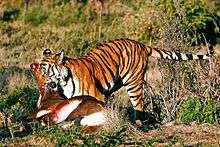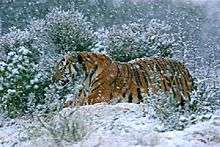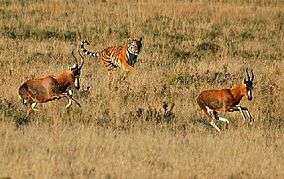Laohu Valley Reserve
| Laohu Valley Reserve | |
|---|---|
|
IUCN category IV (habitat/species management area) | |
|
South China tiger chasing blesbucks in Laohu Valley | |
 Location of Laohu Valley | |
| Location | Northern Cape and Free State provinces, South Africa |
| Nearest city | Philippolis |
| Coordinates | 30°17′14.0″S 25°06′20.2″E / 30.287222°S 25.105611°ECoordinates: 30°17′14.0″S 25°06′20.2″E / 30.287222°S 25.105611°E |
| Area | 1,184,911 km2 (457,497 sq mi) |
| Established | 2002 |
| Governing body | Protected areas of South Africa |
| http://savechinastigers.org/ | |
The Laohu Valley Reserve (LVR) is a nature reserve located near Philippolis in the Free State and near Vanderkloof Dam in the Northern Cape of South Africa.[1][2] It is a roughly 350-square-kilometre private reserve.
It has been created with the aims of nurturing captive-born South China tigers (Panthera tigris amoyensis) in South Africa and eventually releasing them into the wild of China. It is also aimed to restore the South African biodiversity within the Laohu Valley Reserve in general.
History
The Laohu Valley Reserve was created in 2002 out of 17 defunct sheep farms,[3][4][5] and efforts to return the overgrazed land to natural status are ongoing. The South China tigers at LVR for rewilding are kept confined to a tiger-proof camp complex of roughly 1.8 square kilometres, with other areas of the reserve being used to protect native South African species. The word "laohu" is a Chinese term for tiger.[6]
Wildlife conservationist Li Quan initially enlisted the help of John Varty (wildlife filmmaker) and Dave Varty (eco-tourism developer) in South Africa to assist in the rehabilitation process.[7] However, Li Quan and her husband, investment banker Stuart Bray, became concerned that the Vartys were misusing the project's funds to buy land for themselves. Later, in July 2002, the Vartys admitted to borrowing a small portion of Bray's money.[7] After a legal audit, it was discovered that over R5-million had been borrowed by the Vartys, having been used to pay off the Vartys' Londolozi Productions debt on unauthorized salaries. Some of the money was also said to have gone into the Vartys' personal loan accounts and towards paying off their Betty's Bay seaside property.[7][8] Finally, in October 2002, a few weeks before an agreement was due to be signed with Chinese authorities after the Chinese Wildlife Department began to recognize the project's conservation value, the Vartys pulled out of the project.[7] John Varty has since founded his own "tiger rewilding" project, Tiger Canyons, also near Philippolis, using the land he acquired with Bray's funds. However, because Tiger Canyons uses unendangered hybrid breeds of tigers, it has been criticized as having no conservation value, as well as for being used solely for the purpose of creating the film Living with Tigers, which would air on Discovery Channel.[9]
Due to the action spearheaded by Save China's Tigers (SCT), other efforts to convert defunct sheep farms into wildlife farms in this area have been gaining speed. In other words, SCT is a leader in restoring South African biodiversity to the area of Phillippolis of Free State in South Africa.
Effects of tigers on South Africa's ecosystem and biodiversity

There are people who oppose the project because they are afraid that the tigers, being considered an alien species, will affect the South African biodiversity negatively.
However, the project will not cause such a problem as Laohu Valley Reserve has been converted from 17 pieces of defunct sheep farms that were overgrazed; thus no healthy ecosystems existed there at all. In addition, the tigers are in fenced-off camps – hence the South China tigers never roam outside Laohu Valley Reserve and there is, therefore, no contact between them and any healthy ecosystem that exists nearby. On the contrary, instead of having negative effects on South Africa's biodiversity, the project actually has positive effects on it. This is because the defunct sheep farms have been restored and converted into a wildlife reserve that is beneficial to the South African ecosystem. This can be considered the contribution of the South China tigers to the biodiversity of South Africa. Without the Chinese tigers, the land for the project in South Africa would never have been purchased.
Save China's Tigers do not believe there will be any side-effect to the local ecology.[10]
Geography
The Laohu Valley Reserve is one of the largest protected areas in South Africa, comprising an area of approximately 378 square kilometres (146 sq mi). It is located in the central region of the country. It includes land near Philippolis in the Free State section, which consists of approximately 232 square kilometres (90 sq mi) on the northern side, and spans part of the Orange River in the upper reaches of the Vanderkloof Dam in the Northern Cape section, which consists of approximately 146 square kilometres (56 sq mi) on the southern side. The Free State side of the reserve consists of tiger camps bordered by 6,000 kilometres (3,700 mi) of fence.
Climate

Mean annual rainfall is about 400 mm. About 60% of the annual rainfall occurs in the form of thunderstorms during January-April. The maximum amount of rain generally falls during March, with June generally being the driest month. Summer days are hot, but frost is common during winter, with occasional snowfall.
Flora and fauna
The grasslands of Laohu Valley occur on the lower-lying flat areas, with karroid shrubs on the rocky hill slopes on Karoo dolerite making up roughly 40% of the total area. Fairly dense stands of shrubs and trees occur along rivers and in ravines. Extensive stands of closed, dense Acacia karoo woodlands are found along stretches of the Orange River.

The Laohu Valley Reserve is known to breed rewilded South China tigers (Panthera tigris amoyensis). As of 2015, there were 20 wild individuals living in the reserve, representing about 20% of the world's population of this critically endangered subspecies.[11]
Other than tigers, predators such as wildcats (Felis silvestris), caracals (Caracal caracal) and black-backed jackals (Canis mesomelas), and herbivorous mammals such as plains zebras (Equus quagga), also live within the reserve. It is also home to birds such as crested guineafowl (Guttera pucherani), Egyptian geese (Alopochen aegyptiaca) and South African ostriches (Struthio camelus australis).
The prey menus of the tiger and the lion are similar. The South China tigers prey on blesboks (Damaliscus pygargus phillipsi), springboks (Taurotragus oryx), gemsboks (Oryx gazella), black wildebeest (Connochaetes gnou), blue wildebeest (Connochaetes taurinus), common elands (Taurotragus oryx), impalas (Aepyceros melampus), waterbucks (Kobus ellipsiprymnus), common warthogs (Phacochoerus africanus) and cape hares (Lepus capensis).
In 2013, two male South African cheetahs (Acinonyx jubatus jubatus) were relocated by being taken from the Amakhala Game Reserve and released into the Laohu Valley Reserve. It is noted to be first time that wild cheetahs have been reintroduced to the Free State after a hundred years of regional extinction. However, a female cheetah has yet to be reintroduced to the Laohu Valley Reserve.[12]
See also
References
- ↑ Rare tigers raised in Africa to be rewilded in China
- ↑ "Free State breeds extinct China Tiger". 3 February 2012. Retrieved 16 June 2015.
- ↑ Liu, Cecily (16 October 2010). "Rewilded: Saving the South China Tiger". Retrieved 27 August 2011.
- ↑ Blandy, Fran (13 December 2007). "South China tiger finds hope in South Africa". Retrieved 27 August 2011.
- ↑ "Save China's Tigers - Hope's Story". Retrieved 27 August 2011.
- ↑ http://www.laohuvalleyreserve.org/background/
- 1 2 3 4 "Paper Tigers: South Africa". Retrieved 27 August 2011.
- ↑ "Vartys 'misused' tiger funds". news24. 18 March 2003. Retrieved 27 August 2011.
- ↑ "Tiger Film a Fraud, says The Chinese Tigers South African Trust". Retrieved 27 August 2011.
- ↑ FAQs | Save China's Tigers
- ↑ "Two New Beautiful Cubs!". Savechinastigers.org. 20 November 2015. Retrieved 25 November 2015.
- ↑ "Cheetahs Return to Laohu Valley Reserve & The Free State". Savechinastigers.org. Retrieved 22 August 2015.
